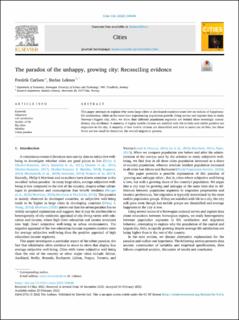| dc.contributor.author | Carlsen, Fredrik | |
| dc.contributor.author | Leknes, Stefan | |
| dc.date.accessioned | 2022-04-05T07:29:22Z | |
| dc.date.available | 2022-04-05T07:29:22Z | |
| dc.date.created | 2022-02-28T12:42:31Z | |
| dc.date.issued | 2022 | |
| dc.identifier.citation | Cities: The International Journal of Urban Policy and Planning. 2022, . | en_US |
| dc.identifier.issn | 0264-2751 | |
| dc.identifier.uri | https://hdl.handle.net/11250/2989777 | |
| dc.description.abstract | This paper attempts to explain why some large cities in developed countries score low on indices of happiness/life satisfaction, while at the same time experiencing population growth. Using survey and register data to study Norway's biggest city, Oslo, we show that different population segments are behind these seemingly contradictory city attributes. A minority of highly mobile citizens are satisfied with life in Oslo and exhibit positive net migration to the city. A majority of less mobile citizens are dissatisfied and tend to move out of Oslo, but these flows are too small to determine the overall migration pattern. | en_US |
| dc.language.iso | eng | en_US |
| dc.publisher | Elsevier | en_US |
| dc.rights | Navngivelse 4.0 Internasjonal | * |
| dc.rights.uri | http://creativecommons.org/licenses/by/4.0/deed.no | * |
| dc.title | The paradox of the unhappy, growing city: Reconciling evidence | en_US |
| dc.type | Peer reviewed | en_US |
| dc.type | Journal article | en_US |
| dc.description.version | publishedVersion | en_US |
| dc.source.pagenumber | 9 | en_US |
| dc.source.journal | Cities: The International Journal of Urban Policy and Planning | en_US |
| dc.identifier.doi | 10.1016/j.cities.2022.103648 | |
| dc.identifier.cristin | 2006132 | |
| cristin.ispublished | true | |
| cristin.fulltext | original | |
| cristin.qualitycode | 1 | |

